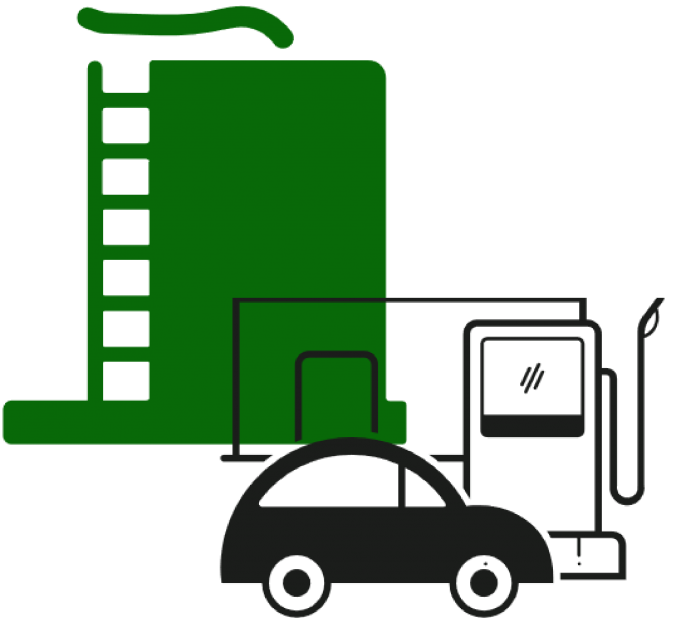Kate Fialko is a fellow in the 2018 Leaders in Environment and Finance (LEAF) program. Kate spent the summer of 2018 with Orange Water and Sewer Authority (OWASA), where she assisted with an investigation into possible productive use of biogas from the wastewater treatment process. She built a preliminary model to determine whether a town could economically convert its fleet to run on CNG.
Many of us know the wastewater treatment process generates water clean enough to put back into the environment, but it also produces biogas. Biogas is the mix of gases produced by anaerobic digestion (the breakdown of organic material in the absence of oxygen) and, since a primary component is methane, it can be used as an alternative fuel source. Utilities commonly use a portion of the biogas they generate to fuel the digestion process and then flare the remaining biogas to dispose of it. Rather than just emit this excess biogas, some utilities are investigating additional ways to productively use biogas in order to save fuel and increase resiliency by creating a new energy source. Options include using the biogas to fuel a combined heat and power system and injecting processed biogas into a natural gas pipeline.
Another option is converting biogas into compressed natural gas (CNG) for use in vehicles. Typically a utility needs to have consistent CNG customers for this to be worthwhile financially, and converting a municipal fleet to run on CNG could provide the needed demand. However, municipalities must carefully consider any fleet conversion decision to ensure they are using tax payer dollars efficiently.
The following are the key considerations of the model for municipal CNG fleet conversion:
1. Determine whether viable CNG alternatives exist for the types of vehicles in the fleet.
Prior to developing a financial model, a municipality should determine which vehicles could be converted to CNG or replaced with new CNG vehicles while still meeting needs. For example, if a police department implements almost exclusively sedans, those would not have the required storage space when CNG tanks are added.
Additionally, municipalities should verify that vehicle manufacturers will honor the warranties of converted vehicles. Ford, for example, only honors the warranty of a CNG-converted vehicle if one of their Qualified Vehicle Modifiers (QVMs) performs the conversion.
2. Identify which eligible vehicles are the best candidates for conversion.
Because a vehicle can be converted to CNG does not necessarily mean it should be. Most cost savings from CNG vehicles come from the lower cost of CNG compared to gasoline. Vehicles with higher annual mileage will have greater avoided fuel costs, allowing the conversion investment to pay off more quickly. A cost-effective candidate for conversion should have high enough annual mileage that the savings on fuel over its lifetime would be greater than the premium for buying or converting to an alternative fuel vehicle.
3. Estimate additional costs associated with a CNG fleet.
Alternative fuel vehicles may have different capital and operation and maintenance costs than traditional vehicles. For example, factory-built CNG vehicles may have higher upfront costs, but converting existing vehicles also comes with costs.
In addition, operating a CNG fleet may require additional training for mechanics and maintaining a CNG fueling station. Existing vehicle maintenance facilities may also need to be retrofitted to meet CNG safety standards. When estimating costs, it is important to keep vehicle and infrastructure lifetimes in mind by building necessary replacement costs into the model.
4. Identify and quantify possible sources of cost savings and revenue.
CNG is typically a less expensive fuel than gasoline, so operating a CNG fleet provides cost savings on fuel. When making a decision about fleet conversion, municipalities should consider how the finances of the project would vary with changes in fuel prices.
Municipalities should also investigate which grants may be available to help pay for necessary infrastructure and initial vehicle conversions or purchases. In North Carolina, Clean Diesel Program grants and Volkswagen settlement funds may be used for alternative fuel vehicle projects. The federal Congestion Mitigation and Air Quality (CMAQ) Improvement Program also provides funding to transportation projects that reduce emissions in areas not meeting National Ambient Air Quality Standards. Grants can be helpful for getting a project off the ground, but the converted fleet should be able to sustain itself after initial grant assistance.
5. Consider the fleet replacement schedule.
Municipalities typically stagger vehicle replacement so that only a small portion of vehicles reach the end of their useful lives in a given year. When looking into CNG fleet conversion, the municipality should decide if it wants to add CNG vehicles in accordance with the replacement schedule, or replace a large portion of vehicles at once to fully utilize the CNG infrastructure from the beginning.
Whichever route the municipality selects should be incorporated into any estimates of savings from CNG fleet conversion. For example, if the municipality sticks with its replacement schedule, only a portion of the possible CNG savings will be realized each year until the entire fleet turns over.
More Resources
Following these steps can allow a municipality to be on its way to considering CNG for its fleet. The following resources provide a few examples of municipalities that have invested in productive uses of biogas or fleet conversions:
Charlotte Water’s Combined Heat and Power Facility
Grand Junction, Colorado’s Biogas to CNG Project
Wilmington’s CNG and Hybrid Vehicles
Kate is an undergraduate student at the University of North Carolina at Chapel Hill, where she is pursuing a degree in Environmental Science with a minor in Information Science. Kate works with the EFC at UNC as a Student Data Analyst, focusing on the water rates surveys and dashboard projects.





Leave a Reply